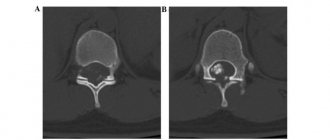Metastasis is the migration of carcinogenic cells from the primary tumor to other organs, which is typical for most cancer tumors. This leads to the formation of secondary lesions in other tissues. Different types of cancer are characterized by different intensity of the metastatic process, which depends on the degree of malignancy and characteristics of the primary tumor. The more intense the spread, the more aggressive the cancer. For example, with skin melanoma, metastases to the brain occur frequently, unlike basal cell carcinoma. The metastatic process begins, as a rule, at the third stage of carcinogenesis, and at the fourth stage it already manifests itself quite strongly. There are two ways for cancer cells to migrate: through the blood and lymph. The appearance of metastatic tumors will be identical to the appearance of the cells of the primary tumor. When neoplasias are detected in the brain, it is important to ensure that these are secondary tumors. For this purpose, a complete examination of the body is carried out. In the presence of metastases in the brain, the prognosis worsens, life expectancy is estimated at months, in some cases weeks.
Metastasis formation
Metastases form after the development of a primary malignant neoplasm in other organs. The latter are formed as a result of mutagenesis or errors in the genetic material of somatic cells. At the initial stages, there is no metastatic process, but as it progresses, the tissues of the primary tumor grow into nearby organs. In the future, the disease worsens, cancer cells begin to break away from the primary focus and migrate through the blood or lymphatic channels (the integrity of the blood vessels is damaged). A metastatic cell attaches itself to an organ, germinates, and gives rise to a new lesion—a secondary tumor.
Important. In different individuals, the nature, timing and intensity of the formation of secondary metastatic foci are different, which is explained by the level of antitumor immunity.
Features of metastasis
The intensity of the metastatic process, the degree of malignancy, the formation of relapses, the treatment of brain metastases and the aggressiveness of cancer are influenced by the following circumstances:
- Stage of carcinogenesis. The life prognosis directly depends on the stage at which the cancer was discovered and surgically removed. The most successful will be removal of cancer at the first stage, however, this cannot guarantee a complete cure, so the patient must be constantly monitored.
- The location of the primary tumor largely determines the nature of the metastatic behavior of cancer and damage to other organs.
- The histological structure and form of cancer also influence the reasons for the spread of metastases. The most dangerous are poorly differentiated forms. Different types of carcinogenesis are characterized by different features of cancer cell migration. If the tumor is dense and slowly growing, for example, cylindroma, then metastases to the brain are rare and, as a rule, only in the terminal stages. In other cases, even with good antitumor immunity, metastases form in the brain, for example, with the development of melanoma.
- Features of anticancer therapy. If it is possible to completely remove the primary tumor in the initial stages, with the administration of radiotherapy and chemotherapy, then in this case the treatment gives the most acceptable result.
- The older the patient, the more difficult the cancer is to treat.
What can headaches mean?
Cephalgia itself is not a typical sign of cancer and is considered exclusively in conjunction with other symptoms. Headaches can also be caused by other reasons, the most common of which are:
- migraines, which are characterized by attacks of throbbing pain that last for several days;
- hypertension, in which pain is localized in the back of the head and parietal area, occurring with sudden jumps in blood pressure;
- VSD and other vascular diseases;
- neurological diseases - pinched nerve roots, vertebrogenic neuralgia, etc.;
- viral or colds, characterized by a sharp increase in temperature;
- inflammation of ENT organs;
- cranial injuries and post-traumatic pathologies;
- stress, overwork, overheating, etc.
It is important to distinguish symptoms characteristic of tumor development from other types of headaches.
Metastases to the brain
Lead to the formation of secondary tumors in various parts of the brain. This almost always causes death. In general, any type of cancer can lead to this, but there are tumors that metastasize more often than other types of cancer:
- Metastases to the brain in skin cancer (melanoma) are more common than in other types. Approximately 50-73% of patients face this problem. In 10-45% of cases (at the time of diagnosis), melanoma is at stage 4, when there are already metastatic lesions. At the same time, every third patient exhibits neurological manifestations. In this case, a condition similar to a stroke often develops, because a hemorrhage forms in the pathological neoplasm. Treatment of brain metastases in melanoma is complicated by the fact that they are poorly sensitive to radiotherapy.
- Metastases in lung cancer form in 35-60% of cases. In this case, how long people live with brain metastases is determined by many factors (age, type of cancer, intensity of carcinogenesis, presence of metastatic lesions in other organs, and so on). According to statistics, such metastases in lung cancer are the most dangerous in terms of mortality. Most often they are characteristic of the fourth stage of pathogenesis. Only in 5% of cases will the patient live 2-3 years. As a rule, at this time there are already multiple neoplasms in the lymph nodes and other organs. The patient receives palliative treatment.
- In breast cancer in women, metastases to the brain are recorded in 20-30% of cases. At later stages, metastases are diagnosed in the brain and many other organs. Treatment is carried out with radiochemotherapy and hormone therapy. The quality of life deteriorates significantly, stroke, mental disorders, vertebral fractures due to brittle bones, cough due to lung damage, and so on are possible.
- Brain metastases in kidney cancer are characteristic of stage 4. In this case, there are secondary lesions in other organs (second kidney, lungs, other organs and multiple lymph nodes). The prognosis is unfavorable: only 8% of patients will live for about two years. Kidney cancer has a high risk of recurrence.
- Metastases from bladder cancer can be at the fourth stage. The prognosis is negative due to the presence of secondary tumors in other organs; most patients will not live more than a year. Removing the cancer is almost impossible; supportive treatment is prescribed.
- Brain metastases in intestinal and esophageal cancer are observed at stage 4. If they are present in other organs, the prognosis is negative - only 6% of patients will live more than a year.
In addition to these types of cancer, metastatic brain lesions can also form in other malignant neoplasms, for example, in the terminal stages of laryngeal or thyroid cancer, when the tumor grows into large main arteries.
Symptoms of brain cancer depending on the stage of the pathological process
In oncology, there are four stages of brain cancer development. Each stage has its own characteristics.
The first stage is characterized by a mild manifestation of symptoms; organ tissues are slightly affected. It is the early detection of a malignant tumor and its surgical removal that gives a chance to save life and a favorable prognosis.
Main manifestations:
- chronic headaches;
- muscle weakness;
- periodic dizziness;
- increased fatigue.
At this stage, it is important to differentiate a brain tumor from neurological diseases.
At the second stage, the process of malignancy of nearby healthy tissue begins. However, in most cases, tumors grow at a slow pace and there is the possibility of complete recovery after surgery.
Additionally, the following symptoms of brain cancer appear:
- nausea, vomiting, disturbances in the gastrointestinal tract;
- increased intracranial pressure;
- poor health in general without significant reasons;
- convulsions;
- epilepsy attacks;
- deterioration of the visual organs.
At the third stage, the tumor grows rapidly, metastasis begins, and treatment, in addition to surgery, includes medications, chemotherapy and radiation therapy.
Signs include:
- hallucinations – sounds are heard and visual images appear;
- speech dysfunction;
- changes in behavior: mood swings, atypical behavior;
- difficulty concentrating;
- memory impairment;
- the pupil is in continuous motion;
- difficulty maintaining balance when walking;
- feeling of numbness in the limbs;
- convulsions, paralysis.
The fourth stage is considered inoperable, and the prognosis is unfavorable. The tumor grows rapidly, and metastases completely affect the brain. The symptoms of brain cancer at this stage include failure of the body’s life support systems, falling into a coma, and cessation of lung function.
Symptoms and signs
As cancer progresses, it enters later stages (3 and 4). In this case, metastases form in the brain, so characteristic clinical signs begin to appear. Manifestations will depend on the area of the brain affected. In many cases, the signs are mirrored, i.e. if the tumor is in the right hemisphere, then the clinic will appear on the left side and vice versa.
Main features:
- dizziness, headache due to increased pressure inside the skull, while negative symptoms are not relieved by medications;
- dyspeptic symptoms, nausea and vomiting (vomiting does not bring relief), which is not associated with poisoning;
- various disorders of brain activity: confusion, memory impairment, speech impairment, epileptic seizures, hallucinations, etc.;
- vision, hearing, and smell suffer;
- the mental and emotional background changes, the person becomes rude, aggressive, overly irritable;
- the formation of epileptiform seizures with brain damage is more typical for the elderly;
- motor activity is impaired, coordination and fine motor skills suffer, it is difficult for the patient to maintain balance, gait is impaired, the ability to write, and so on.
Kinds
Based on the method of tumor formation, oncologists distinguish between brain cancer:
- primary – formed directly from cells belonging to the organ;
- secondary, or metastatic - occurs when metastases from other organs of the body penetrate into the skull.
Primary neoplasms occur 3-4 times less frequently than secondary ones and account for approximately 1.5% of all cases of cancer. The overall incidence of cerebral tumors is 5-6%, and the risk of their development increases with age. In children, this disease is extremely rare - statistics record no more than 2.4 cases per 100 thousand population under the age of 18 years.
Depending on what tissue became the source for the neoplasm, the following types are distinguished.
- Astrocytomas (gangliomas), which develop directly in brain cells and account for up to 80% of all clinical cases.
- Meningiomas, the source tissue for which is the membranes of the brain, and their cells rarely acquire malignant characteristics, although the growth of tumors in any case negatively affects the functioning of the brain.
- Neuromas that grow from the myelin sheath of nerve fibers inside the skull.
- Pituitary adenomas form in the tissue of the pituitary gland and exhibit malignant features in rare cases.
Diagnostics
Since the formation of secondary tumors in the brain causes the death of the patient, it is important to identify the presence of a pathological formation as early as possible. If cancer is present, the patient must be diagnosed continuously to monitor the situation and timely identify secondary tumors in the brain. If the tumor in the head is small, it usually already has a pronounced clinical picture, however, it can be diagnosed at the earliest stages using computed tomography (CT) or magnetic resonance imaging (MRI). A biopsy is important to establish the metastatic process and clarify all the nuances of pathogenesis. The presence of metastases can be suspected even with a biochemical blood test.
Treatment methods and prognosis for further survival
Brain tumors are dangerous not only because of their malignancy, but also because of their location. It is quite difficult to remove a formation that develops in the closed space of the skull without affecting the vital centers. But not all tumors need to be considered fatal.
Once the neurosurgeon determines the boundaries, size and exact location of the tumor, it will become clear how the patient should be treated. If there is even the slightest chance of a successful outcome of the operation, then histology of the malignant tissue will be required, if such a procedure is possible and does not complicate the patient’s condition.
Doctor's advice
Brain surgery is not as scary as it seems. If there is a choice to do or not to do, then refusal means a pessimistic forecast, while consent gives a chance, and not a small one. After treatment with modern devices, in most cases, long rehabilitation is not required, the patient returns to his normal life. During this period, he needs to be supported morally, helped with usual household chores and childcare. Students can read the curriculum little by little, this will help them get into a familiar rhythm. If you have panic attacks, neurosis, or depression that develops as a result of an illness, you need to consult a psychologist. All this is very important for recovery.
Victoria Druzhikina Neurologist, Therapist
Treatment is always complex. At an early stage of cancer, all available methods are used: radiosurgery, cryosurgery, radiation and chemotherapy, surgery, symptomatic therapy. The goal is not only to cure cancer; first, it is necessary to relieve pain, alleviate the general condition and prevent swelling of the brain.
The survival prognosis for people with early stage brain cancer depends on two factors: the accuracy and timeliness of diagnosis.
If treatment is started immediately, about 82% of patients survive after five years. With late presentation, the five-year survival rate is only 31%. The prognosis largely depends on the type, aggressiveness and growth rate of the tumor.
Brain tumors are strikingly different from other malignant tumors and occur in approximately 3% of all recorded cases of oncology. They are located so inconveniently that the symptoms of the disease are difficult to differentiate, and this significantly complicates treatment.
The basis for referral to an oncology clinic is sudden development and increasing neurological symptoms. However, modern medicine has hardware diagnostic tools that can not only detect cancer at an early stage, but also identify predisposition to it.
For more information about the symptoms of a brain tumor, watch the video:
Be healthy!
Useful articles on the topic: Why women may feel dizzy: common causes Tension headaches: causes, types of pathology, symptoms and effective treatments
This article has been verified by a current qualified physician, Victoria Druzhikina, and can be considered a reliable source of information for site users.
Rate how helpful this article was
5 2 people voted, average rating 5
Did you like the article? Save it to your wall so you don’t lose it!
Treatment
What to do in case of metastases in the brain is decided by a council of doctors based on the diagnosis and medical history of the patient. Treatment of metastases in the head is very difficult, which is due to the inaccessibility of the location of secondary lesions in the brain, the presence of multiple tumors in other organs, the patient’s condition in the later stages, age and a number of other factors. Today, in the presence of secondary tumors in the head, stereotactic radiosurgical techniques are used, which stop or slow down the growth of pathological tissue. The best result is achieved when tumors are removed surgically, but at these stages treatment is always difficult. The method of treatment will depend on the location of the tumor, the intensity of damage to other organs and the general condition of the patient.
Main types of treatment
- Surgical treatment is possible only in cases where there is access to tumors in the brain. As a rule, in the terminal stages many other organs are already affected, so surgical treatment is carried out mainly for palliative purposes, to eliminate negative signs and alleviate the patient’s condition. In some cases, it is possible to remove a few tumors or metastases are removed en bloc (when they are located nearby). If there are many lesions in the brain, then surgical treatment is not advisable.
- Treatment with radiotherapy is more preferable in this case. For deep, hard-to-reach locations of secondary tumors in the brain, this type of treatment is the main one. For a few tumors, stereotactic proton therapy (irradiation of an organ from several sides) will be an effective method.
- Chemotherapy and drug treatment for brain metastases are not effective. Drugs are prescribed to relieve negative symptoms and reduce side effects. Thus, drug therapy is palliative.
Rehabilitation
To return the patient to a normal lifestyle after treatment, the doctor may prescribe rehabilitation procedures depending on the nature and extent of brain damage.
- Physical therapy is necessary to restore motor coordination and muscle strength.
- Classes with a speech therapist are useful for speech disorders.
- Treatment by a psychologist or psychotherapist is required for patients with developed depression, memory and thinking disorders.
- Taking anticonvulsant medications to prevent epileptic seizures.
After completing treatment, you must remember that brain tumors can recur, and you need to undergo regular preventive examinations.









